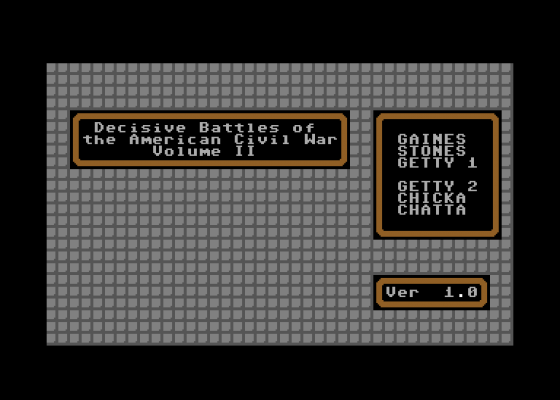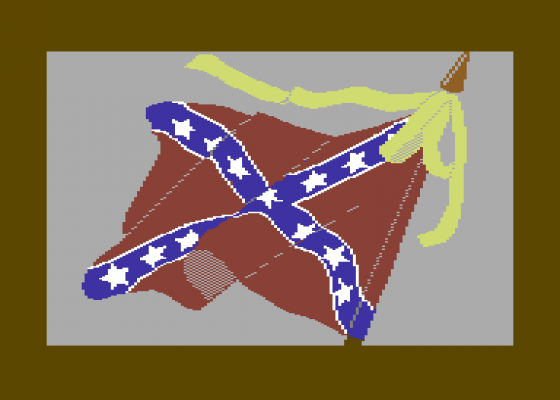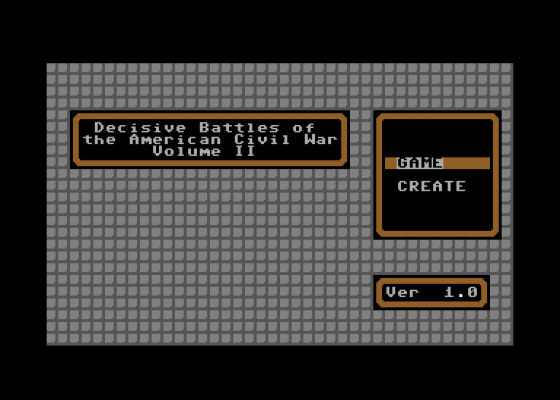
Zzap
 1st October 1988
1st October 1988
Categories: Review: Software
Publisher: Strategic Studies Group
Machine: Commodore 64
Published in Zzap #42
Get down and groove with PI the GI, this time donning a cloak in Skara Brae with Bard's Tale III and treading more common ground in SSG's American Civil War simulation.. (Who writes these intros?)
Decisive Battles Of The American Civil War II
Decisive Battles Of The American Civil War II is a most business-like title, promising a solid and no-nonsense historical simulation for the serious battle re-enactor. The software comes packaged in a card folder identical to that of Battles In Normandy and Russia, with a high-quality colour map of the five battle sites and a chunky 48-page rulebook. Trimmings are cards depicting flowcharts of the game, design and start menus and strip of pre-printed game save disk labels. The physical components offered for the price give an impression of value.
It concerns itself with five important battles from the middle years of the war, from Gaines Mill in June 1982 to Chattanooga in November 1863, and includes a two-part recreation of the three-day Gettysburg battle, the turning-point of the war. Doubtless Volume Three will follow with the closing stages of the war.
Despite a considerable quantity of closely-printed words in the rulebook, and a full summary of the background to and historical course of each featured battle, there is no explanation of the circumstances behind the American Civil War itself. This is an unfortunate omission in a game with such a thoroughly historical approach, and the battles are difficult to put into context without a basic background. The designers of Decisive Battles tend to assume a reasonable knowledge of the American Civil War on the part of the player, although there is a brief general introduction.

The first scenario in Volume Two is the battle off Gaines Mill, which took place on the 27th June 1962. The background notes begin 'During McClellans retreat from Richmond...' Who is McClellan? Which side is he on? What happened at Richmond? Where, indeed, is Richmond? Independent research on your part is certainly needed to make the most sense out of these scenarios, and to put the excellently detailed accounts of the battles into context.
The battles are recreated on a large scale, in both time and space. Turns cover a single hour, and map hexes contain individual buildings. The fighting units are divided into Corps and subdivided into Brigades, though the structure of command is not really spelled out in the rulebook and it takes a bit of searching and deduction to make sense of it. Anyone unaccustomed to SSG games will realise as soon as they glance through the rulebook that they will have to be prepared to invest a fair amount of time in studying the orders structure. There is a tutorial whch takes the player through the first tune of the 'Gettysburg' scenario, but it is not sufficiently explanatory to allow you to carry one with the rest of the game with confidence.
A series of branching menus deal with orders, information and game options. There are a few choices to be made before the start of play. Six scenarios are offered: Gaines Mill, Stones River, Gettysburg Part One and Two, Chickamauga and Chattanooga. Given the precise historical details and the large scale of the simulation there is no option to string these together into a 'make your own Civil War' scenario, but there is an amazingly comprehensive facility to edit them out of all recognition. Historically sensible variations are suggested in the rulebook, but every aspect can be altered and - with a graphics editor facility too, that allows you to redraw map icons and units pixel by pixel - Decisive Battles effectively doubles up as a wargame construction kit, more flexible and thorough than the SSG Wargame Construction Kit reviewed last month.

The game can be plae with or without hidden movement, and with or without radio contact. There was, of course, no radio contact between brigades on the field and the army HQ in the 1860s, and the commander did not have X-ray vision either; for an authentic atmosphere, 'exposed' and 'radio' should be left unselected. The player can choose to give a slight, minor ot major advantage to either side, and in addition can select the 'enhanced' option which gives the computer-controlled forces bonuses for a really difficult game. Finally, the player can decide whether he wants to lead the forces of the Union North or the Confederate South.
The screen display is not particularly artistic, but the map is supplemented by the supplied map, and an option on one of the menus allows access to a wide variety of information about each hex. The 'map hex' eature calls up the cover value, movement point cost and 'line of sight' value of each feature. Many of the hexes contain individual named buildings. This single cursor-controlled facility also displays full statistical information about friendly brigades, which is as extensie as you would expect in a detailed wargame of this kind.
Liberally dotted about the landscape, and flashing on and off to make themselves conspicuous, are the 'objectives'. These are the all-important strategic hexes whose capture means success, and which make the gameplay of SSG wargames characteristically more realistic then others which calculate the winner in terms of dead bodies. Combat losses are taken into account in the final summing up stage, but the number of victory points gained from capturing and holding objectives are more important in determining the outcome. Each objective is worth a certain number of victory points per turn, and a bonus may be awarded for holding it at the end of the game. It usually does not become active until some turns into the game, and may cease to be important after some turns more. There are even a few objectives which yield no victory points at all; perhaps they are included simply to indicate strategically useful positions to the player.

Combat is handled automatically by the computer in two 'attacked' and 'defender' phases, but although the unit that the player's brigade will attack is selected by the computer it is possible to predict which this will be. The rules governing combat are fully explained in the games system section of the rulebook, which also gives the formulae affecting sighting of enemy units and communicating with friendly units without the benefit of the 'radio' option.
An atmospheric touch is the leadership profile menu, which allows the player to choose how brave he wants his army commander to be. By selecting the 'heroic' option the leader throws himself into the front line, personally encourages and cheers on the troops, and exposes himself to the danger of being killed. At the other extreme 'cautious' commanders will hide in the barracks. Most of the time the commander will be 'sensible' and incur the normal 2% risk of death or injury.
Verdict
Presentation 94%
Superb packaging and physical components, and a branching menus orders system that combines complexity with ease of use.

Graphics 60%
Not very inspiring.
Rules 90%
Copious, with game mechanics thoroughly explained, but confusing for the player who wants to make a quick start. The tutorial chapter is not as helpful as it could be.
Authenticity 92%
The individual battles are obviously well-researched, and reproduced on the screen with statistical accuracy.
Playability 88%
Quick and compelling.
Overall 90%
Another top quality wargame from SSG, offering undoubted value for money.




